Macroeconomics: A Critical Analysis of GDP as a Measure of Well-being
VerifiedAdded on 2023/04/08
|7
|1237
|301
Essay
AI Summary
This essay critically evaluates Gross Domestic Product (GDP) as a measure of economic well-being, acknowledging its widespread use while highlighting its limitations. It discusses how GDP, while effectively capturing a nation's aggregate output, fails to account for crucial qualitative aspects such as leisure time, environmental quality, non-market activities (e.g., household work), and income distribution. The essay references alternative measures like the Genuine Progress Indicator (GPI) and the Human Development Index (HDI), which attempt to incorporate social and environmental factors for a more comprehensive assessment of societal welfare. The author reflects on the arguments for and against GDP, suggesting the need for a more holistic welfare measure that integrates qualitative indicators to provide a more accurate representation of economic well-being.
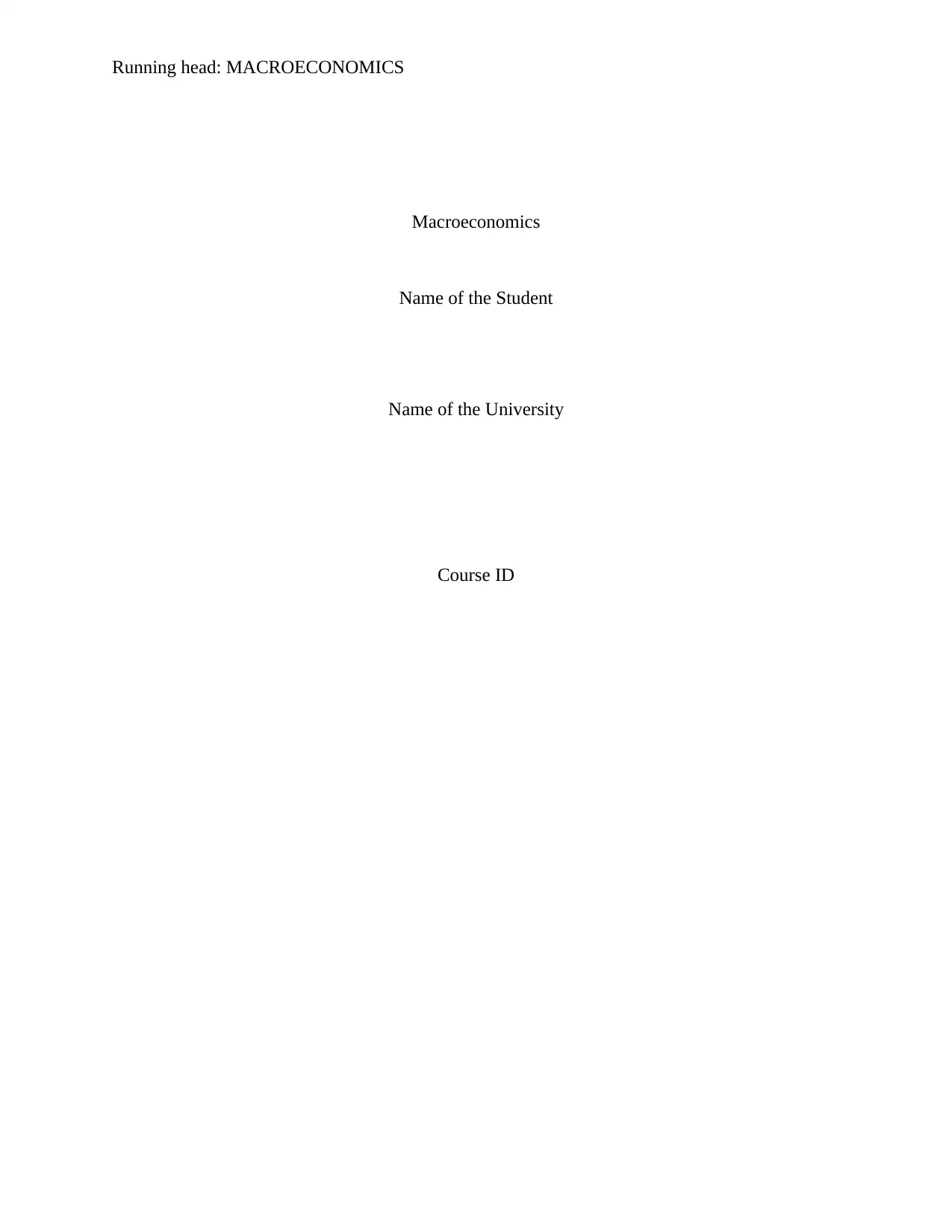
Running head: MACROECONOMICS
Macroeconomics
Name of the Student
Name of the University
Course ID
Macroeconomics
Name of the Student
Name of the University
Course ID
Paraphrase This Document
Need a fresh take? Get an instant paraphrase of this document with our AI Paraphraser
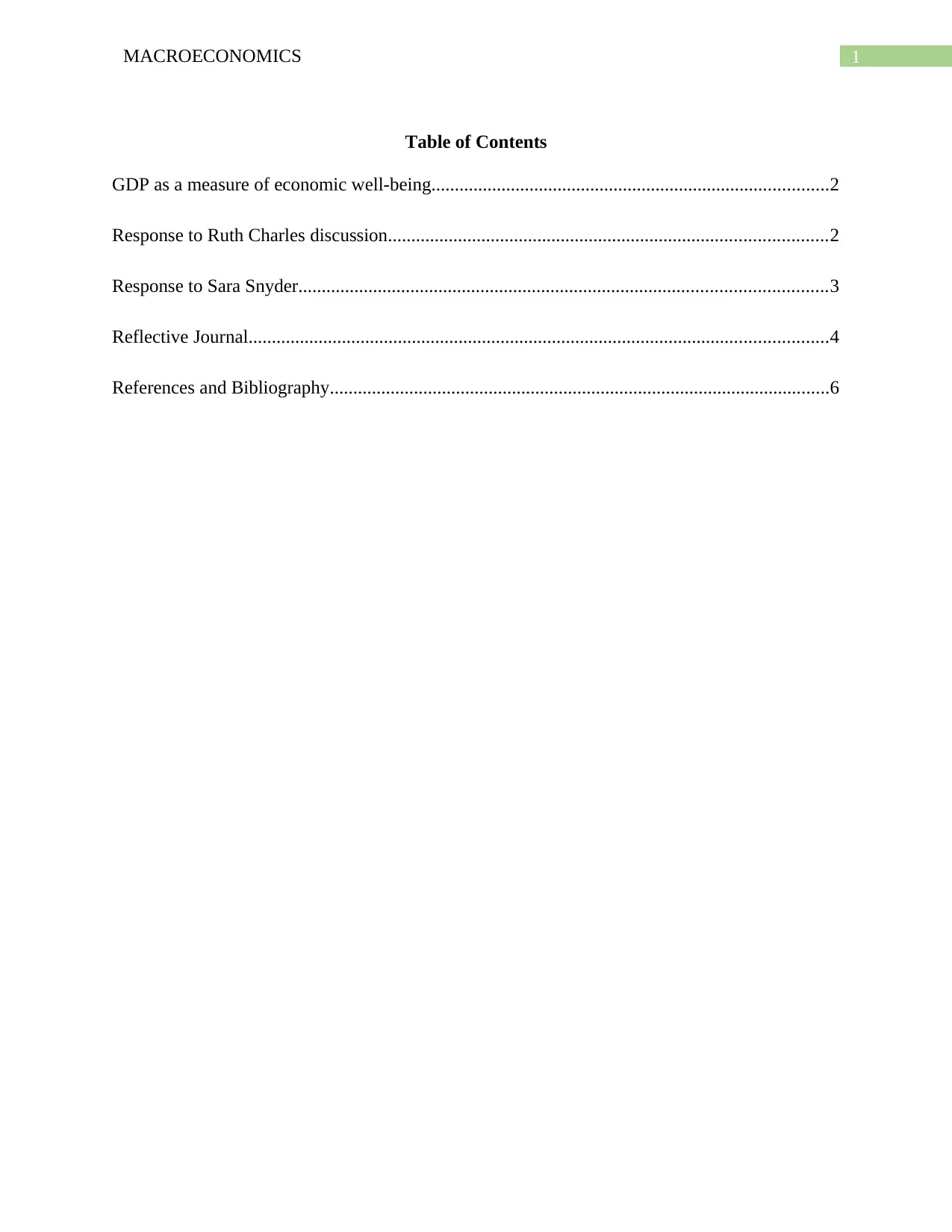
1MACROECONOMICS
Table of Contents
GDP as a measure of economic well-being.....................................................................................2
Response to Ruth Charles discussion..............................................................................................2
Response to Sara Snyder.................................................................................................................3
Reflective Journal............................................................................................................................4
References and Bibliography...........................................................................................................6
Table of Contents
GDP as a measure of economic well-being.....................................................................................2
Response to Ruth Charles discussion..............................................................................................2
Response to Sara Snyder.................................................................................................................3
Reflective Journal............................................................................................................................4
References and Bibliography...........................................................................................................6
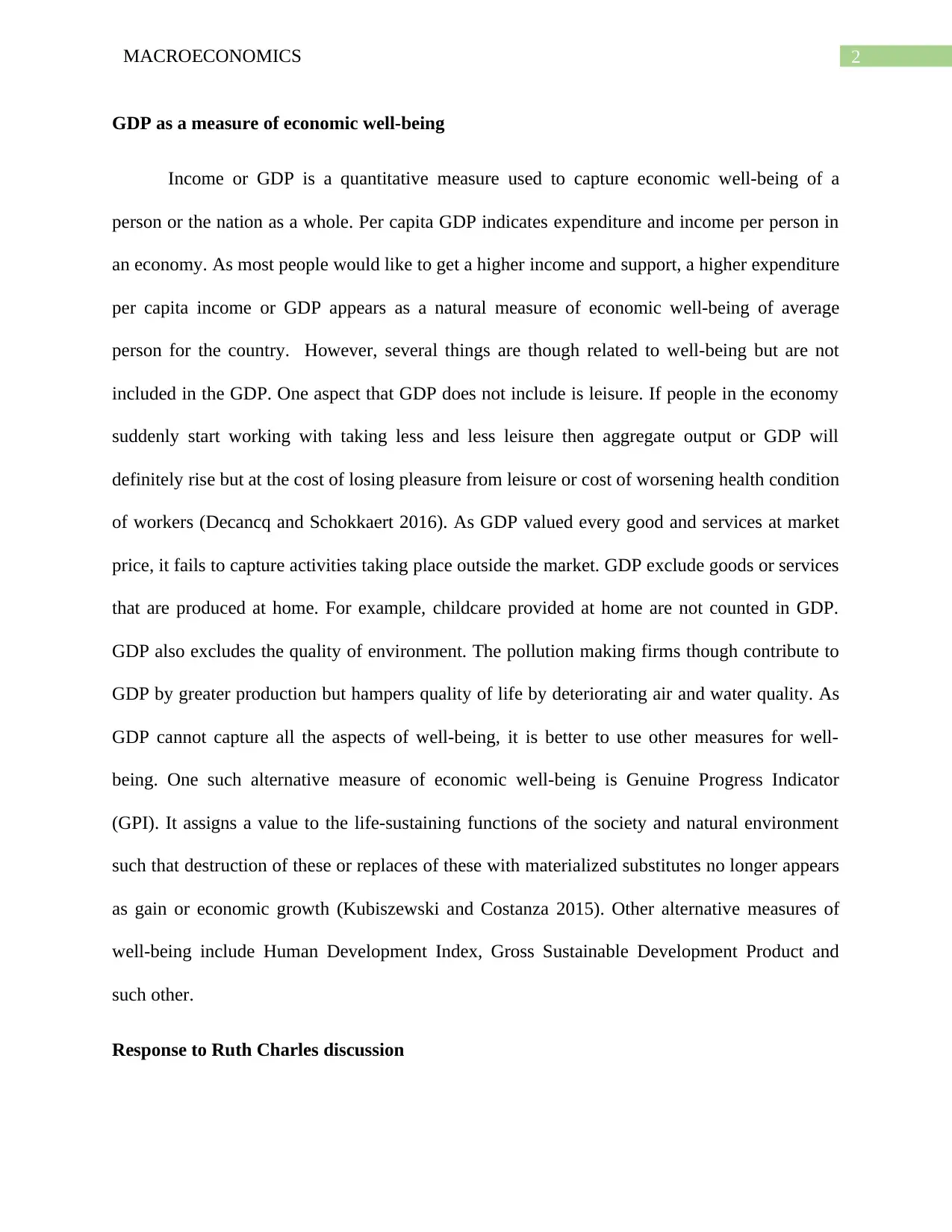
2MACROECONOMICS
GDP as a measure of economic well-being
Income or GDP is a quantitative measure used to capture economic well-being of a
person or the nation as a whole. Per capita GDP indicates expenditure and income per person in
an economy. As most people would like to get a higher income and support, a higher expenditure
per capita income or GDP appears as a natural measure of economic well-being of average
person for the country. However, several things are though related to well-being but are not
included in the GDP. One aspect that GDP does not include is leisure. If people in the economy
suddenly start working with taking less and less leisure then aggregate output or GDP will
definitely rise but at the cost of losing pleasure from leisure or cost of worsening health condition
of workers (Decancq and Schokkaert 2016). As GDP valued every good and services at market
price, it fails to capture activities taking place outside the market. GDP exclude goods or services
that are produced at home. For example, childcare provided at home are not counted in GDP.
GDP also excludes the quality of environment. The pollution making firms though contribute to
GDP by greater production but hampers quality of life by deteriorating air and water quality. As
GDP cannot capture all the aspects of well-being, it is better to use other measures for well-
being. One such alternative measure of economic well-being is Genuine Progress Indicator
(GPI). It assigns a value to the life-sustaining functions of the society and natural environment
such that destruction of these or replaces of these with materialized substitutes no longer appears
as gain or economic growth (Kubiszewski and Costanza 2015). Other alternative measures of
well-being include Human Development Index, Gross Sustainable Development Product and
such other.
Response to Ruth Charles discussion
GDP as a measure of economic well-being
Income or GDP is a quantitative measure used to capture economic well-being of a
person or the nation as a whole. Per capita GDP indicates expenditure and income per person in
an economy. As most people would like to get a higher income and support, a higher expenditure
per capita income or GDP appears as a natural measure of economic well-being of average
person for the country. However, several things are though related to well-being but are not
included in the GDP. One aspect that GDP does not include is leisure. If people in the economy
suddenly start working with taking less and less leisure then aggregate output or GDP will
definitely rise but at the cost of losing pleasure from leisure or cost of worsening health condition
of workers (Decancq and Schokkaert 2016). As GDP valued every good and services at market
price, it fails to capture activities taking place outside the market. GDP exclude goods or services
that are produced at home. For example, childcare provided at home are not counted in GDP.
GDP also excludes the quality of environment. The pollution making firms though contribute to
GDP by greater production but hampers quality of life by deteriorating air and water quality. As
GDP cannot capture all the aspects of well-being, it is better to use other measures for well-
being. One such alternative measure of economic well-being is Genuine Progress Indicator
(GPI). It assigns a value to the life-sustaining functions of the society and natural environment
such that destruction of these or replaces of these with materialized substitutes no longer appears
as gain or economic growth (Kubiszewski and Costanza 2015). Other alternative measures of
well-being include Human Development Index, Gross Sustainable Development Product and
such other.
Response to Ruth Charles discussion
⊘ This is a preview!⊘
Do you want full access?
Subscribe today to unlock all pages.

Trusted by 1+ million students worldwide
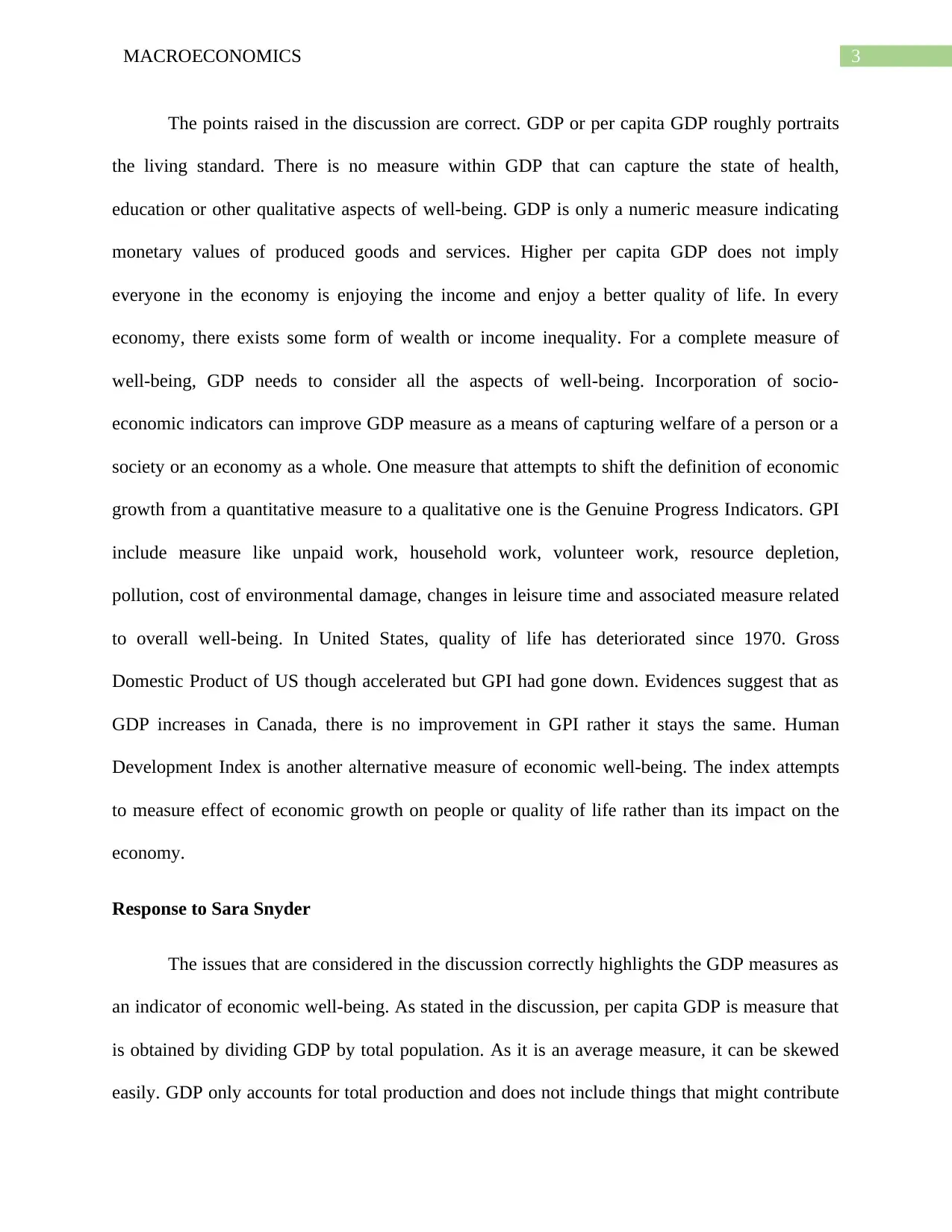
3MACROECONOMICS
The points raised in the discussion are correct. GDP or per capita GDP roughly portraits
the living standard. There is no measure within GDP that can capture the state of health,
education or other qualitative aspects of well-being. GDP is only a numeric measure indicating
monetary values of produced goods and services. Higher per capita GDP does not imply
everyone in the economy is enjoying the income and enjoy a better quality of life. In every
economy, there exists some form of wealth or income inequality. For a complete measure of
well-being, GDP needs to consider all the aspects of well-being. Incorporation of socio-
economic indicators can improve GDP measure as a means of capturing welfare of a person or a
society or an economy as a whole. One measure that attempts to shift the definition of economic
growth from a quantitative measure to a qualitative one is the Genuine Progress Indicators. GPI
include measure like unpaid work, household work, volunteer work, resource depletion,
pollution, cost of environmental damage, changes in leisure time and associated measure related
to overall well-being. In United States, quality of life has deteriorated since 1970. Gross
Domestic Product of US though accelerated but GPI had gone down. Evidences suggest that as
GDP increases in Canada, there is no improvement in GPI rather it stays the same. Human
Development Index is another alternative measure of economic well-being. The index attempts
to measure effect of economic growth on people or quality of life rather than its impact on the
economy.
Response to Sara Snyder
The issues that are considered in the discussion correctly highlights the GDP measures as
an indicator of economic well-being. As stated in the discussion, per capita GDP is measure that
is obtained by dividing GDP by total population. As it is an average measure, it can be skewed
easily. GDP only accounts for total production and does not include things that might contribute
The points raised in the discussion are correct. GDP or per capita GDP roughly portraits
the living standard. There is no measure within GDP that can capture the state of health,
education or other qualitative aspects of well-being. GDP is only a numeric measure indicating
monetary values of produced goods and services. Higher per capita GDP does not imply
everyone in the economy is enjoying the income and enjoy a better quality of life. In every
economy, there exists some form of wealth or income inequality. For a complete measure of
well-being, GDP needs to consider all the aspects of well-being. Incorporation of socio-
economic indicators can improve GDP measure as a means of capturing welfare of a person or a
society or an economy as a whole. One measure that attempts to shift the definition of economic
growth from a quantitative measure to a qualitative one is the Genuine Progress Indicators. GPI
include measure like unpaid work, household work, volunteer work, resource depletion,
pollution, cost of environmental damage, changes in leisure time and associated measure related
to overall well-being. In United States, quality of life has deteriorated since 1970. Gross
Domestic Product of US though accelerated but GPI had gone down. Evidences suggest that as
GDP increases in Canada, there is no improvement in GPI rather it stays the same. Human
Development Index is another alternative measure of economic well-being. The index attempts
to measure effect of economic growth on people or quality of life rather than its impact on the
economy.
Response to Sara Snyder
The issues that are considered in the discussion correctly highlights the GDP measures as
an indicator of economic well-being. As stated in the discussion, per capita GDP is measure that
is obtained by dividing GDP by total population. As it is an average measure, it can be skewed
easily. GDP only accounts for total production and does not include things that might contribute
Paraphrase This Document
Need a fresh take? Get an instant paraphrase of this document with our AI Paraphraser
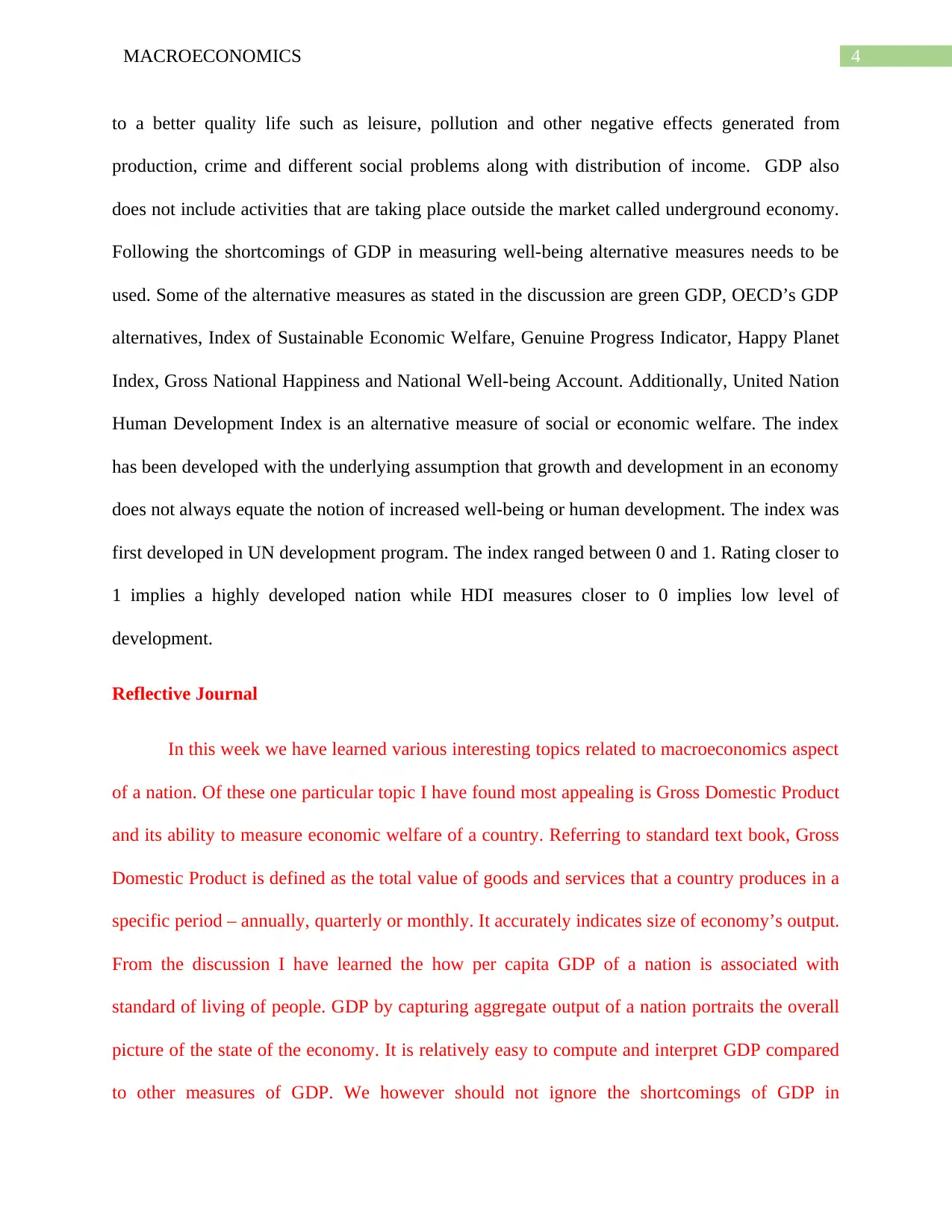
4MACROECONOMICS
to a better quality life such as leisure, pollution and other negative effects generated from
production, crime and different social problems along with distribution of income. GDP also
does not include activities that are taking place outside the market called underground economy.
Following the shortcomings of GDP in measuring well-being alternative measures needs to be
used. Some of the alternative measures as stated in the discussion are green GDP, OECD’s GDP
alternatives, Index of Sustainable Economic Welfare, Genuine Progress Indicator, Happy Planet
Index, Gross National Happiness and National Well-being Account. Additionally, United Nation
Human Development Index is an alternative measure of social or economic welfare. The index
has been developed with the underlying assumption that growth and development in an economy
does not always equate the notion of increased well-being or human development. The index was
first developed in UN development program. The index ranged between 0 and 1. Rating closer to
1 implies a highly developed nation while HDI measures closer to 0 implies low level of
development.
Reflective Journal
In this week we have learned various interesting topics related to macroeconomics aspect
of a nation. Of these one particular topic I have found most appealing is Gross Domestic Product
and its ability to measure economic welfare of a country. Referring to standard text book, Gross
Domestic Product is defined as the total value of goods and services that a country produces in a
specific period – annually, quarterly or monthly. It accurately indicates size of economy’s output.
From the discussion I have learned the how per capita GDP of a nation is associated with
standard of living of people. GDP by capturing aggregate output of a nation portraits the overall
picture of the state of the economy. It is relatively easy to compute and interpret GDP compared
to other measures of GDP. We however should not ignore the shortcomings of GDP in
to a better quality life such as leisure, pollution and other negative effects generated from
production, crime and different social problems along with distribution of income. GDP also
does not include activities that are taking place outside the market called underground economy.
Following the shortcomings of GDP in measuring well-being alternative measures needs to be
used. Some of the alternative measures as stated in the discussion are green GDP, OECD’s GDP
alternatives, Index of Sustainable Economic Welfare, Genuine Progress Indicator, Happy Planet
Index, Gross National Happiness and National Well-being Account. Additionally, United Nation
Human Development Index is an alternative measure of social or economic welfare. The index
has been developed with the underlying assumption that growth and development in an economy
does not always equate the notion of increased well-being or human development. The index was
first developed in UN development program. The index ranged between 0 and 1. Rating closer to
1 implies a highly developed nation while HDI measures closer to 0 implies low level of
development.
Reflective Journal
In this week we have learned various interesting topics related to macroeconomics aspect
of a nation. Of these one particular topic I have found most appealing is Gross Domestic Product
and its ability to measure economic welfare of a country. Referring to standard text book, Gross
Domestic Product is defined as the total value of goods and services that a country produces in a
specific period – annually, quarterly or monthly. It accurately indicates size of economy’s output.
From the discussion I have learned the how per capita GDP of a nation is associated with
standard of living of people. GDP by capturing aggregate output of a nation portraits the overall
picture of the state of the economy. It is relatively easy to compute and interpret GDP compared
to other measures of GDP. We however should not ignore the shortcomings of GDP in
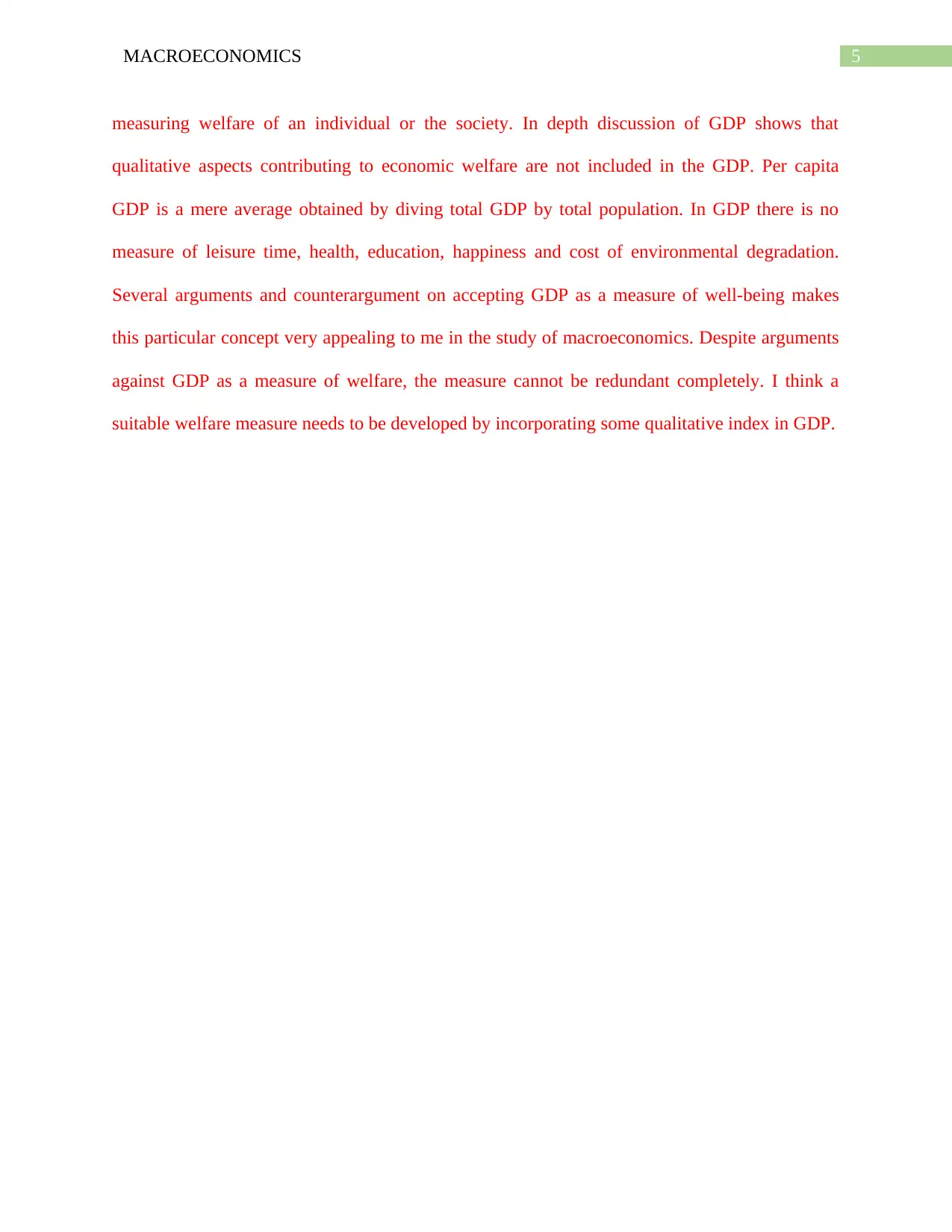
5MACROECONOMICS
measuring welfare of an individual or the society. In depth discussion of GDP shows that
qualitative aspects contributing to economic welfare are not included in the GDP. Per capita
GDP is a mere average obtained by diving total GDP by total population. In GDP there is no
measure of leisure time, health, education, happiness and cost of environmental degradation.
Several arguments and counterargument on accepting GDP as a measure of well-being makes
this particular concept very appealing to me in the study of macroeconomics. Despite arguments
against GDP as a measure of welfare, the measure cannot be redundant completely. I think a
suitable welfare measure needs to be developed by incorporating some qualitative index in GDP.
measuring welfare of an individual or the society. In depth discussion of GDP shows that
qualitative aspects contributing to economic welfare are not included in the GDP. Per capita
GDP is a mere average obtained by diving total GDP by total population. In GDP there is no
measure of leisure time, health, education, happiness and cost of environmental degradation.
Several arguments and counterargument on accepting GDP as a measure of well-being makes
this particular concept very appealing to me in the study of macroeconomics. Despite arguments
against GDP as a measure of welfare, the measure cannot be redundant completely. I think a
suitable welfare measure needs to be developed by incorporating some qualitative index in GDP.
⊘ This is a preview!⊘
Do you want full access?
Subscribe today to unlock all pages.

Trusted by 1+ million students worldwide
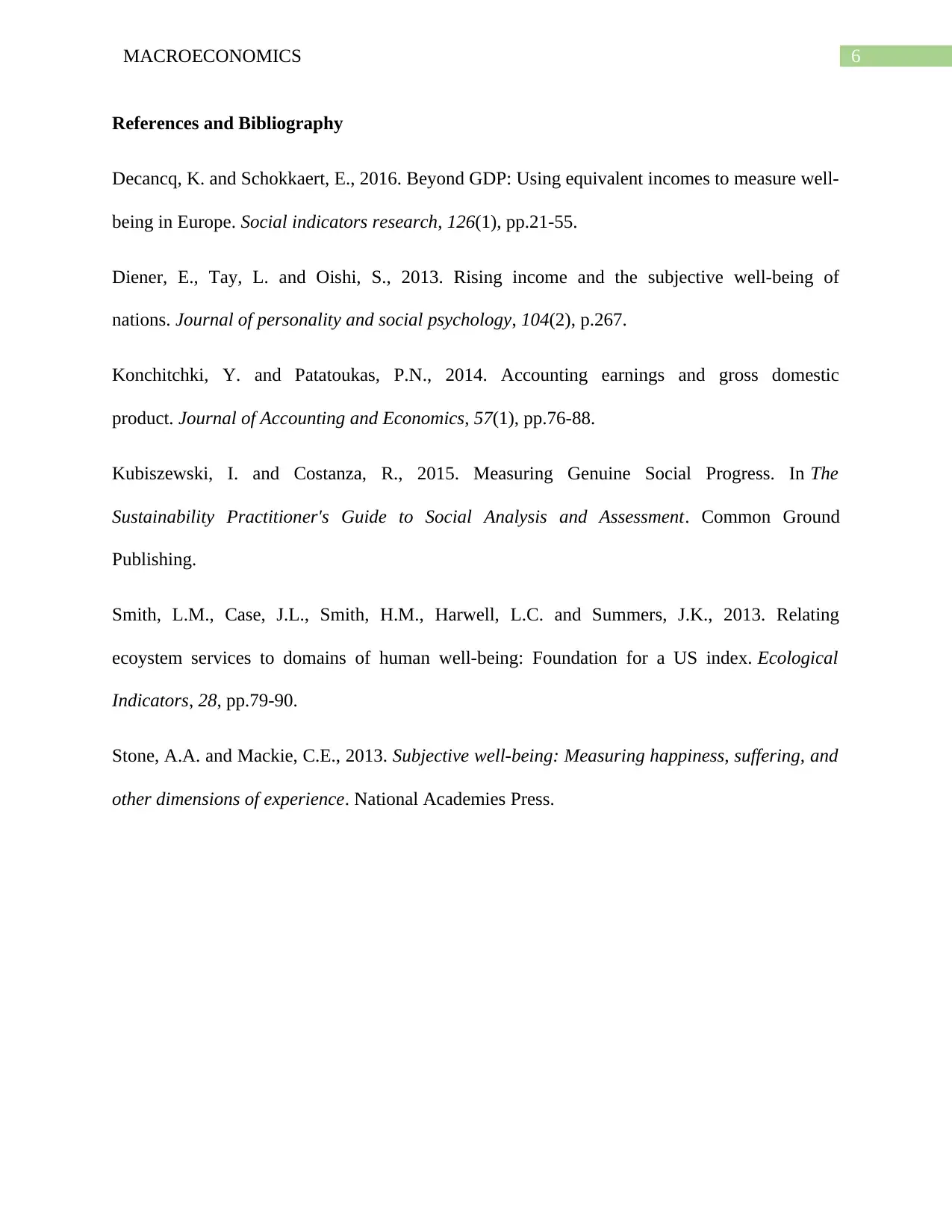
6MACROECONOMICS
References and Bibliography
Decancq, K. and Schokkaert, E., 2016. Beyond GDP: Using equivalent incomes to measure well-
being in Europe. Social indicators research, 126(1), pp.21-55.
Diener, E., Tay, L. and Oishi, S., 2013. Rising income and the subjective well-being of
nations. Journal of personality and social psychology, 104(2), p.267.
Konchitchki, Y. and Patatoukas, P.N., 2014. Accounting earnings and gross domestic
product. Journal of Accounting and Economics, 57(1), pp.76-88.
Kubiszewski, I. and Costanza, R., 2015. Measuring Genuine Social Progress. In The
Sustainability Practitioner's Guide to Social Analysis and Assessment. Common Ground
Publishing.
Smith, L.M., Case, J.L., Smith, H.M., Harwell, L.C. and Summers, J.K., 2013. Relating
ecoystem services to domains of human well-being: Foundation for a US index. Ecological
Indicators, 28, pp.79-90.
Stone, A.A. and Mackie, C.E., 2013. Subjective well-being: Measuring happiness, suffering, and
other dimensions of experience. National Academies Press.
References and Bibliography
Decancq, K. and Schokkaert, E., 2016. Beyond GDP: Using equivalent incomes to measure well-
being in Europe. Social indicators research, 126(1), pp.21-55.
Diener, E., Tay, L. and Oishi, S., 2013. Rising income and the subjective well-being of
nations. Journal of personality and social psychology, 104(2), p.267.
Konchitchki, Y. and Patatoukas, P.N., 2014. Accounting earnings and gross domestic
product. Journal of Accounting and Economics, 57(1), pp.76-88.
Kubiszewski, I. and Costanza, R., 2015. Measuring Genuine Social Progress. In The
Sustainability Practitioner's Guide to Social Analysis and Assessment. Common Ground
Publishing.
Smith, L.M., Case, J.L., Smith, H.M., Harwell, L.C. and Summers, J.K., 2013. Relating
ecoystem services to domains of human well-being: Foundation for a US index. Ecological
Indicators, 28, pp.79-90.
Stone, A.A. and Mackie, C.E., 2013. Subjective well-being: Measuring happiness, suffering, and
other dimensions of experience. National Academies Press.
1 out of 7
Related Documents
Your All-in-One AI-Powered Toolkit for Academic Success.
+13062052269
info@desklib.com
Available 24*7 on WhatsApp / Email
![[object Object]](/_next/static/media/star-bottom.7253800d.svg)
Unlock your academic potential
Copyright © 2020–2025 A2Z Services. All Rights Reserved. Developed and managed by ZUCOL.



